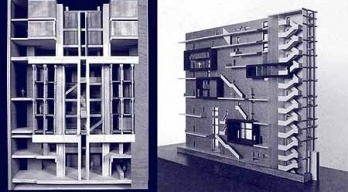
Proposta para ponte, Barcelona. Battle i Roig, Archis Novembro 2000
Ana Paula Baltazar: How do you see critically the Dutch architecture and its impacts in the worldwide scene (considering that the very way it sells itself through celebration generates an impact), and mainly how do you locate the work of Rem Koolhaas in the scenario of "overdose" of images (many times sold as concepts) of the contemporary architecture, specially in the Dutch architecture? (the comment on Rem Koolhaas is a special request from Abilio Guerra).
Ole Bouman: What should be avoided is the confusion of success of Dutch architecture and the successful proliferation of media strategies by Dutch architects. These are two completely different things. If it comes to actual building, in Holland there are as always and as anywhere exceptions that prove the rule. The exceptions are being done by a relatively high talented generation of both designers and clients. The rule is the mindless mass production of architectural funnies and pragmatic sheds.
APB: Being critical and having a very specific agenda towards redefining architecture as cultural media (as you do) doesn't seem to be an easy task when it involves to maintain an expensive publication such as Archis. Apart from being the editor-in-chief of Archis, you also collaborate in practical developments of this new culture of architecture beyond the scale of building as object. I'd like you to connect the role played by Archis with your own practice towards the potential of architecture as a contemporary medium itself. To what extent is Archis' critical approach influenced by your own practical involvement in projects such as transPORT 2001 (and others you might be involved), and how do you see the insertion and influence of such projects in the worldwide architecture?
OB: What could be a decisive side-effect of the mediatisation of Architecture, is that in the end architectural design can better be done with publishing strategies, than through designing space. Architecture and publishing in the new age are both focussed on creating social and semiotic relations. There is no distinction anymore between primary production and secondary coverage. There is also a waning distinction between the physical and the cybernetic. These realms merge and this will go on till the distinction is forgotten. If this is true, there will be a completely practice. What I do as participant in design work, is not 'my other practice', but another modality of the same ambition: creating social relation in a meaningful, liberating and critical way. To produce public domain...

Jaco Woltjer, modelo de biblioteca / Isabelle Krier, object arquitetônico sobre maquete da costa bélgica. Archis Agosto 2000



